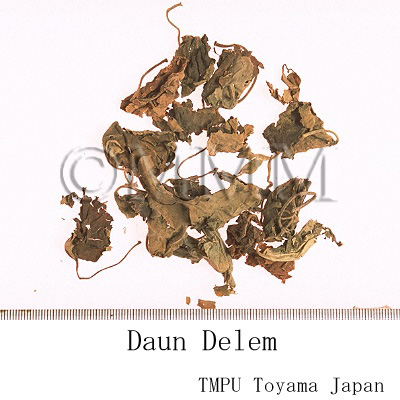Crude drug sample data base
※Click on the image to enlarge it.
Scientific information data base
| Crude drug name | Indonesian name, English name | Daun dilem, Patchouli | |||
|---|---|---|---|---|---|
| Synonyms | Daun nilam | ||||
| crude drug image |
| ||||
| Original plant name | Pogostemon cablin Benth. | ||||
| Family name | Labiatae | ||||
| Used part | Leaves | ||||
| Distribution area | Mainly in East Asia. | ||||
| Description | There are 3 species of Pogostemon, all of them have the same local name "dilem" [201]. Pogostemon cablin is the most common type of patchouli. Locally it is known as Aceh Patchouli. The leaves are green, simple, elliptical to ovate, apex acute, base round, margin irregularly serrate, pubescent and glandular on both surfaces; petiole 2-10 mm long, hairy, stipule absent. The top leaf is shinny green and the bottom part of the leaf appears dull and hairy, containing most of the oil in the plant. The plant is an herb, erect or procumbent, strong smelling, 30-80 cm tall. Stem bluntly 4-angular, pubescent with spreading hairs [201]. P. heyneanus, known as ''dilem kembang'', grows wild in the forests of Java. The leaves are thin, dark green and rather pointed. It flowers and has a relatively low oil content for commercial use [201]. P. hortensis, known as ''dilem Jawa'' and the primary area of production is West Java. The leaf is shiny, smooth and thin, similar to P. heyneanus but it does not flower [201]. | ||||
| Specific actions | Antiseptic, sudorific, stomachic [231]. | ||||
| Frequency in use | Moderate. | ||||
| Common uses | The leave contains an essential oil, namely patchouli oil. Leaves are used for washing traditional clothes (e.g. sarong and batik) which is believed is one of the best ways to retain the colour from fading. | ||||
| Pharmacological effect | From the n-hexane extract of Pogostemon cablin, patchouli alcohol, pogostol, stigmast-4-en-3-one, retusin, and pachypodol were tested and exhibited anti-emetic effects [PMID: 10374246]. A methanol extract from Pogostemon cablin showed a suppressive effect on umu gene expression of SOS response in Salmonella typhimurium TA1535/pSK1002 against the mutagen 2-(2-furyl)-3-(5-nitro-2-furyl)acrylamide (furylfuramide). The methanol extract was re-extracted with hexane, dichloromethane, butanol, and water. A dichloromethane fraction showed a suppressive effect [PMID: 10725128]. Essential oil from Pogostemon cablin Benth., showed antibacterial activity against periodontopathic bacteria, including Actinobacillus, Capnocytophaga, Fusobacterium, Eikenella and Bacteroides species [PMID: 2133438]. | ||||
| Medical system | Indonesian medicine (Jamu) | ||||
| Traditional usage | A poultice made from leaves is used to treat diarrhoea/diarrhea, colic, worms, sores, kidney problems, sore throat [220]. The leaves are chewed against colic and flatulence. Leaves are also used for eliminating bad body odour and as an insect repellent [220]. It is used as an antiseptic, sudorific and stomachic and is used to cure irregular menstruation, stomach upset, dysmenorrhea, headache and haemorrhoid/hemorrhoid. The infusion of the leaves is used to allay painful menstruation [231]. | ||||
| Formulation | 1) Bad body odour: 100 grams of fresh leaves is boiled with 10 liters of water for 15 minutes and the decoction is used for bathing [207]. 2) Haemorrhoids/hemorrhoids: Ingredients are 7 pieces of leaves of P. cablin, 7 pieces of leaves of Coleus amboinicus, 1 handful of aboveground parts of Eclipta alba, 1 handful of aboveground part of Euphorbia prostata, 1 fruit of Helicteres isora. All ingredients are boiled with 110 ml of water to make a decoction. Drink 100 ml of the decoction once a day for 14 days [231]. | ||||
| References | Reference book Tips! | [201] K. Heyne, Tumbuhan Berguna Indonesia, Vols. 1-4, 1987. Diedarkan Oleh Koperasi Karyawan Departemen Kehutanan, Jakarta, Indonesia. Vol. 3, p 1844. [207] Badan Penelitian Dan Pengembangan Kesehatan and Departemen Kesehatan, Kesejahteraan Sosial Ri. Vols. 1-5, Inventaris Tanaman Obat Indonesia, Jakarta, Indonesia. Vol. 1, Part 2 (2001), pp 153-154. [221] Lemmens, R.H.M.J. and Bunyapraphatsara, N. (editors): Plant Resources of South-East Asia No, 12 (3). Medicinal and poisonous plants 3. Prosea Foundation, Bogor, Indonesia. 2003. pp 231-233. [228] Christophe, Wiart.: Medicinal Plants of Southeast Asia. Prentice Hall. Malaysia. 2002. pp 316-317. [231] Soedibyo, Mooryati: Alam Sumber Kesehatan: Manfaat dan Kegunaan (Natural resources for health. Benefits and uses). Balai Pustaka. 1998. p 123. | |||
| Research paper | 1. Miyazawa M, Okuno Y, Nakamura S, Kosaka H. Antimutagenic activity of flavonoids from Pogostemon cablin. J Agric Food Chem. 48(3):642-7, 2000. (PMID: 10725128) 2. Yang Y, Kinoshita K, Koyama K, Takahashi K, Tai T, Nunoura Y, Watanabe K. Anti-emetic principles of Pogostemon cablin (Blanco) Benth. Phytomedicine. 6(2):89-93, 1999. (PMID: 10374246) 3. Osawa K, Matsumoto T, Maruyama T, Takiguchi T, Okuda K, Takazoe I. Studies of the antibacterial activity of plant extracts and their constituents against periodontopathic bacteria. Bull Tokyo Dent Coll. 31(1):17-21, 1990. (PMID: 2133438) | ||||
| Last renewal date | 2024/02/29 | ||||




